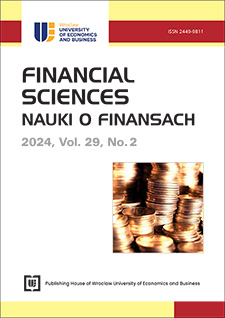Individual Investors and Corporate Bonds Market. Evidence from Poland
DOI:
https://doi.org/10.15611/fins.2024.2.03Keywords:
corporate bonds, capital market, bondsAbstract
Aim: The aim of this article was to identify the preferences of individual investors in the context of investing in corporate bonds.
Methodology: The study was based on two questionnaire studies with closed questions, conducted in 2018 and 2024.
Findings: Firstly, the interest in investing in corporate bonds has been decreasing on the part of individual investors surveyed, while at the same time their investment portfolio has increased. Secondly, investors in both 2018 and 2024 indicated the same main factors that helped them in their investment decisions. Thirdly, the attitude towards the issuers’ industries has changed.
Implications: The study has a high implicative value for corporate bond issuers, indicating areas that are important for individual investors.
Originality/value: The article supplements the literature with the results of a survey on the area of corporate bonds in Poland.
Downloads
References
Bhutta, U. S., Tariq, A., Farrukh, M., Raza, A., & Iqbal, M. K. (2022). Green Bonds for Sustainable Development: Review of Literature on Development and Impact of Green Bonds. Technological Forecasting and Social Change, 175, 121-378. https://doi.org/10.1016/j.techfore.2021.121378
Chen, Y., & Jiang, L. (2020). Liquidity Risk and Corporate Bond Yield Spread: Evidence from China. International Review of Finance, 21(4), 1117-1151. https://doi.org/10.1111/irfi.12322
Choi, J., & Kim, Y. (2018). Anomalies and Market (Dis)Integration. Journal of Monetary Economics, 100, 16-34. https://doi.org/10.1016/j.jmoneco.2018.06.003
Dick-Nielsen, J., Feldhütter, P., & Lando, D. (2012). Corporate Bond Liquidity Before and After the Onset of the Subprime Crisis. Journal of Financial Economics, 103(3), 471-492. https://doi.org/10.1016/j.jfineco.2011.10.009
Dykto, M. (2008). Obligacje korporacyjne i komunalne jako alternatywna dla obligacji skarbowych forma lokowania oszczędności inwestorów indywidualnych. Acta Universitatis Lodziensis. Folia Oeconomica, 218, 35-47.
Gemra, K. (2016). Rynek Catalyst szansą na dywersyfikację źródeł finansowania przedsiębiorstw. Kwartalnik Nauk o Przedsiębiorstwie, 40(3), 81-94.
Gradoń, W. (2014). Emisja obligacji korporacyjnych a ryzyko uczestników rynku. Studia Ekonomiczne/Uniwersytet Ekonomiczny w Katowicach, 171, 94-108.
Hotchkiss, E. S., & Ronen, T. (2002). The Informational Efficiency of the Corporate Bond Market: An Intraday Analysis. Review of Financial Studies, 15(5), 1325-1354. https://doi.org/10.1093/rfs/15.5.1325
Hu, X., Zhong, A., & Cao, Y. (2022). Greenium in the Chinese Corporate Bond Market. Emerging Markets Review, 53, 100946. https://doi.org/10.1016/j.ememar.2022.100946
Huang, J., & Huang, M. (2012). How Much of the Corporate-Treasury Yield Spread is Due to Credit Risk? The Review of Asset Pricing Studies, 2(2), 153-202. https://doi.org/10.1093/rapstu/ras011
Kang, J., & Pflueger, C. E. (2015). Inflation Risk in Corporate Bonds. The Journal of Finance, 70(1), 115-162. https://doi.org/10.1111/jofi.12195
Kłosowska, B., & Buszko, M. (2012). Obligacje korporacyjne jako źródło finansowania małych i średnich przedsiębiorstw – uwarunkowania, ryzyko, rozwój. Zeszyty Naukowe Uniwersytetu Szczecińskiego. Ekonomiczne Problemy Usług, 297-309.
Larcker, D. F., & Watts, E. M. (2020). Where’s the Greenium? Journal of Accounting and Economics, 69(2-3), 101312. https://doi.org/10.1016/j.jacceco.2020.101312
Lepczyńskki, B., & Pisarewicz, P. (2018). Ochrona praw obligatariuszy przed naruszeniami i nadużyciami emitentów na przykładzie obligacji spółki GetBack SA. Prace Naukowe Uniwersytetu Ekonomicznego We Wrocławiu, 531, 313-324.
Maltais, A., & Nykvist, B. (2020). Understanding the Role of Green Bonds in Advancing Sustainability. Journal of Sustainable Finance & Investment, 1-20. https://doi.org/10.1080/20430795.2020.1724864
Orliński, B. (2014). Obligacje korporacyjne jako źródło pozyskiwania kapitału dla małych i średnich przedsiębiorstw. Zeszyty Naukowe Uniwersytetu Szczecińskiego. Ekonomiczne Problemy Usług, 441-451.
Piechota, R. (2018). Ryzyko kredytowe obligacji korporacyjnych notowanych na rynku Catalyst. Przedsiębiorstwo & Finanse, 4, 55-69.
Ślażyńska-Kluczek, D. (2022). Zielone obligacje jako metoda finansowania projektów inwestycyjnych. Kwartalnik Nauk o Przedsiębiorstwie, 63(1), 33-44. https://doi.org/10.33119/knop.2022.63.1.3
Van Zundert, J., & Driessen, J. (2022). Stocks versus Corporate Bonds: A Cross-sectional puzzle. Journal of Banking & Finance, 137, 106447. https://doi.org/10.1016/j.jbankfin.2022.106447
Zunino, L., Bariviera, A. F., Guercio, M. B., Martinez, L. B., & Rosso, O. A. (2016). Monitoring the informational efficiency of European corporate bond markets with dynamical permutation min-entropy. Physica a Statistical Mechanics and Its Applications, 456, 1-9. https://doi.org/10.1016/j.physa.2016.03.007
Downloads
Published
License
Copyright (c) 2025 Kamil Gemra, Janusz Maruszewski

This work is licensed under a Creative Commons Attribution-ShareAlike 4.0 International License.
Accepted 2025-01-27
Published 2025-01-28








